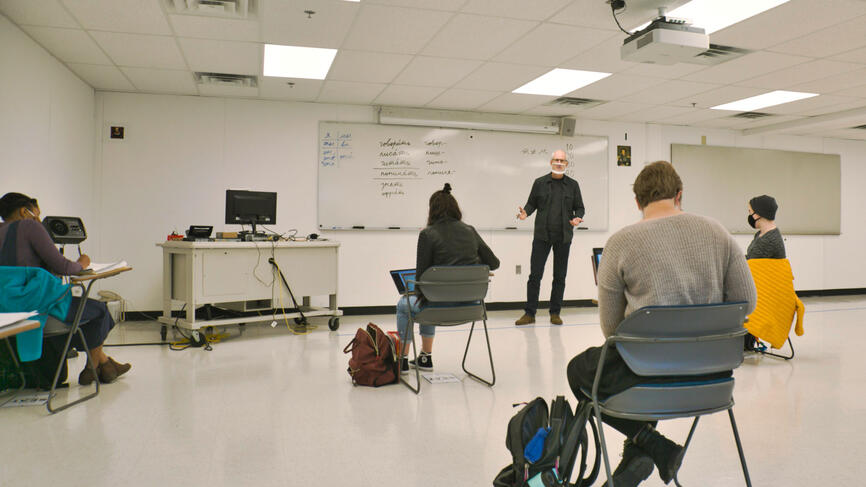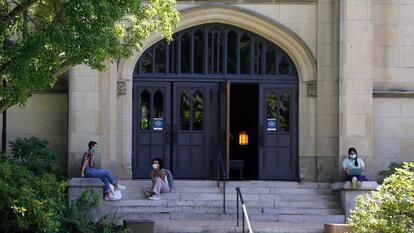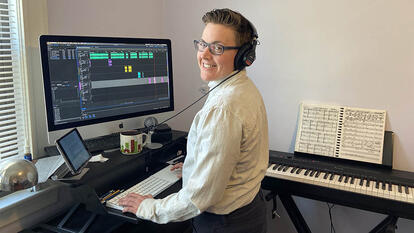Reconfigured Spaces, Reconfigured Teaching
When faculty and students returned to classrooms in September 2020, they were following strict COVID-19 guidelines to keep the community safe: limited numbers of students in a class, adequate spacing between students and the professor; unexpected spaces converted into classrooms; and, of course, masks for everyone. They made it through an entire semester (divided into two seven-week terms) of in-person courses.
Below, a few professors share their thoughts on what teaching was like under these new circumstances.

Jennifer Chudy, Knafel Assistant Professor of Social Sciences and assistant professor of political science: I had a positive experience teaching in person. Sometimes the masks and distance made it hard for me to gauge students’ reactions to the material. There were also times where I would tell what I thought were very funny jokes, only to receive muffled (or no?) laughs. Despite these challenges, we managed. My background in performing arts made me feel comfortable on stage. The content—American politics during an election year—also complemented the auditorium’s dramatic setting.

Thomas Hodge, professor of Russian: The students in my term 1 Russian 101 class were clearly excited to be learning in person again. While the spaced-out rows and columns of desks made us look like a human spreadsheet, and my clear mask transformed me into a balding Kylo Ren, everyone adapted quickly and cheerfully. I stayed behind my line at the front of the class, but I never felt far away from the students. Their warmth and flexibility made it a joy to be back in the physical classroom!

T. James Kodera, professor of religion: In term 1, I was assigned to teach Introduction to Asian Religions in the Houghton Chapel. At first, I felt a bit strange teaching a course on Asian religions in a hallowed hall, founded and dedicated to Christian worship. I shared that sense of awkwardness with the students in the class. With time, however, we found the cavernous space of the chapel quite conducive to our teaching and learning experience. We all wore a face mask. There was an ample supply of hand sanitizer in the back of the chapel. If proper precautions are taken, as they were, it provided an authentic teaching and learning experience, which I felt could not be accomplished by staring at the computer screen. An ancient Chinese sage, Lao Tzu, remarked: “Learning at its best is shared.” I believe he believed in actual in-person sharing, and not virtual sharing through cyberspace.

Elizabeth Oakes, senior instructor in chemistry laboratory: Overall, teaching chemistry labs with all of the COVID-19 precautions worked better than I expected it to. In order to accommodate as many students as possible while maintaining physical distancing, we taught 24 students concurrently across three lab rooms, with two instructors circulating among the three rooms. Team teaching in this context was challenging, but the students were so happy to be doing hands-on labs that it was definitely worth it. The main challenges were not being able to see computer screens or demonstrate techniques effectively from six-plus feet away; making sure to talk with all 24 of the students frequently enough to answer all of their questions and help them to work effectively together; and the decreased amount of time we had for the lab period (45 minutes shorter), which meant that we needed to cut much of the in-lab pre- and post-lab discussions and rely on students coming to office hours to talk about interpreting their data and understanding the rationale behind the experimental steps.

Akila Weerapana, associate professor of economics: I was very nervous about teaching Econ 102 in Alumnae Hall. It seemed to go against everything I had known before about teaching at Wellesley—a big auditorium, no writing on the board, not being able to see my students’ faces (both because of distances and masks), feeling like I was a performer on a stage rather than a facilitator in a group. By the end of the semester, I had changed my mind completely and that is because the essence of teaching at Wellesley—the students—was unchanged. My 102 students were active, engaged, came to class prepared and asked questions, took on a brutal workload and pace without much complaint, and all in all reminded me why I love this place so much.


